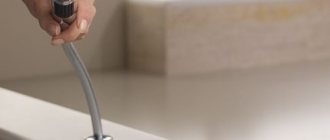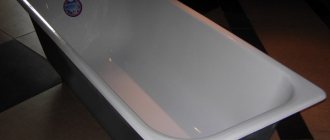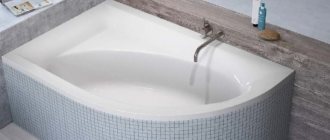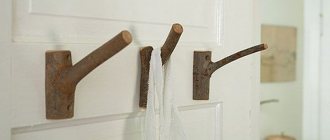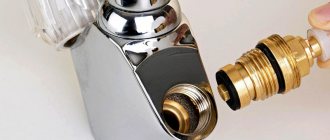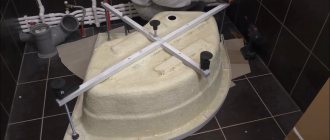When renovating a bathroom, as a rule, not only the plumbing is changed, but also the exhaust system. So, for the bathroom you should install a “drain/overflow” system, which is also called a plumbing. This device is familiar to everyone, and in its traditional design it is quite simple. But today an automatic bathtub harness has appeared, as well as its semi-automatic analogue. Let's consider what is special about such a system, as well as the nuances of installing the harness.
The so-called bathroom overflow fitting is a system of drain pipes that is designed to drain liquid from a container and prevent water from overflowing. After finishing using the bathtub, open the drain hole located at the bottom of the container.
There is a fairly wide pipe installed here, which is part of the siphon or is inserted into it. An overflow hole is installed in the upper part of the bathtub, which comes into operation if too much water is collected in the bathtub. However, the tube on the overflow is usually thin, so if there is sufficient pressure of water entering the bath, it is not always possible to avoid a flood.
Why do you need a bathtub piping and how does it work?
The name “drain-overflow” is due to two holes in the bathtub fitting:
- upper, which is necessary to minimize water overflow;
- the lower one through which drainage occurs.
A bathtub fitting is a device similar to a regular siphon, the overflow neck of which is equipped with a rotation lever connected by a cable to a similar mechanism in the drain neck. Turning the rotation lever increases or decreases the tension of the cable, and the mechanism in the drain neck is activated, raising or lowering the plug. This eliminates the need to manually install and remove the plug.
Bathtub trim option
Classification of bathtub trims
Bath fittings are classified according to two main principles:
- by design features;
- according to materials. The drain and overflow can be metal or plastic.
Metal or plastic - which is better?
The metal device can be made of stainless steel, brass, copper with a chrome surface. Products of this type are distinguished by their reliability, durability and long service life, but are characterized by a whole list of disadvantages, the main of which are:
- high prices;
- the need for precise adjustment of all parts of the system, which makes installation difficult;
- accumulation of debris and fatty deposits in the system, which requires regular cleaning with chemicals.
Metal bathtub trim
Advantages of plastic devices
High-quality plastic bathtub piping is much cheaper than metal, but is not inferior to it in reliability and, with careful use, durability. The plastic intended for the manufacture of such products is not subject to corrosion and has the following characteristics:
- high strength;
- durability;
- resistance to high temperatures and aggressive environments;
- the ability not to accumulate dirt and fat deposits.
If necessary, the plastic model can be easily replaced without much financial loss.
Bathtub trim option
Purpose
Let's figure out where the name drain-overflow comes from. It's simple. There are two openings in the bathtub: lower and upper. In the first, a drain mechanism is installed, and in the second, an overflow mechanism.
The bottom hole is required to drain water from the bowl. If you need to fill the bathtub with water, then this hole is closed with a special device. The top hole is needed to level out the likelihood of water overflowing and flooding the room. A siphon connects both holes, and they are tied.
You should not assume that overwatering will save you in every situation. We must not forget that at a certain intensity of water flow, the amount of water supplied will be greater than that output. This means that water will accumulate in the bathroom until it spills onto the floor.
Types of bath trim
Having studied some of the subtleties of the question of what a bathtub piping is, you can familiarize yourself with the design features of different models. Three types of products are produced:
- A universal model with a stopper on a chain, designed for any type of bathtub - acrylic, steel, cast iron. This device, consisting of a siphon, a drain neck with a metal cover for the lid, an overflow neck with a cover of the same type and a flexible hose connecting the drain neck with the overflow by pulling it onto a fitting or using nuts, is characterized by its simple design and low cost.
- A semi-automatic device, the characteristic feature of which is a rotary lever connected by a cable to the plug. Depending on the direction of rotation of this part, the drain opens or closes.
- The automatic bath fitting is easy to use and has no fragile parts. You can close or open the drain by lightly pressing the plug, which is easy to do even with your heel. Very convenient are the machines, which provide the ability to draw water and open the drain in a semi-automatic mode. There is no need to install a mixer with such a drain-overflow system.
There are specially designed models for non-standard bathtubs and custom-made containers.
Dismantling the old trim
Dismantling of old equipment is carried out in several steps. First you need to rinse and clean the outer layer of the bath well, then disassemble the worn-out device. The old plastic siphon, as well as the overflow, are unscrewed with pliers.
The cast iron harness is removed using a grinder with a 115 mm disc. All actions are carried out in a circle, in sectors. Next, push in a flat-head screwdriver to engage the upper part of the siphon adjacent to the bathtub.
Similar manipulations are carried out with overflow. Then you need to loosen the siphon with a hammer and pull it out of the drainage pipe. If problems arise with rusted bolts, then use improvised means, for example, a kitchen knife or a bottle opener.
Using such devices, they cut the stainless steel and take out the lid that covers the drain hole. Disassembling the automatic system is simple. First of all, remove the plug and unscrew the mounting bolt using pliers or a wrench.
To remove the overflow bolt, you need to unscrew the wing using a flat-head screwdriver. Next, after removing it, unscrew the bolt and easily dismantle the entire structure. Currently, many models of bathtub trims from various manufacturers are sold.
Plumbers recommend purchasing piping from good manufacturers. This will allow you to save money on repair work during operation.
Disadvantages of semi-automatic and automatic devices
In addition to numerous advantages, including convenience and ease of use, semi-automatic and automatic devices have a number of disadvantages:
- semi-automatic machines made of plastic are characterized by fragility of structural elements that can break under intense mechanical pressure on the lever or strong water pressure. It is almost impossible to repair such a breakdown - you will have to buy a new bathtub fitting;
- To lift the plug in a semi-automatic device, a cable is used that connects the drain and overflow blocks, and to close or open the drain hole, you need to turn the overflow cap. In inexpensive products, the cable quickly wears out and becomes unusable, so it is preferable to choose products from German brands;
- a characteristic feature of the machines is the hole under the plug, which often causes blockages in the drain neck;
- plastic machines, especially cheap models, are unreliable, so it is better to purchase products made of metal.
Replacement
The procedure is relatively simple. First you need to remove the old system. If it is made of plastic, then you just need to unscrew it. If it is made of cast iron, you will have to saw it. This is a more labor-intensive process that can take half an hour.
After dismantling the old device, it is necessary to clean the surface of the bath in the area of the holes from contaminants accumulated during operation. Next we are installing a new drain and overflow.
This procedure includes the installation of drain pipes that connect the bathtub and the sewer pipe going into the apartment or house, as well as the installation of drain and overflow grates and pipes between these openings. All plastic trim elements should be tightened by hand, without the use of tools. All joints should be sealed with FUM tape. It also wouldn't hurt to use silicone sealant.
First, a metal grille is installed on the overflow and connected to the upper tube. The lower device is also secured. A long bolt is used. Rubber gaskets are installed on both sides of the connection.
Next, the water filter is connected. The installation is considered complete if the siphon operation test is positive. All connections should be checked for leaks.
How to choose the right drain and overflow
When choosing a frame, you need to take into account the material from which the bathtub is made and the thickness of its walls. For example, thin-walled steel containers require a drain and overflow of a special design.
An equally significant factor when purchasing is the appearance of the product. Our photo gallery presents models made of white plastic or polypropylene, non-ferrous metals with a glossy and matte chrome surface. If desired, you can choose a decorative metal frame in silver, platinum, gold, equipped with forged curly legs. The drain and overflow made of ferrous metal has high performance characteristics, but is completely unpresentable in appearance. It can be disguised with a special removable screen.
Installing a bathtub trim
On our website in the gallery there are models of any design for bathtubs of all types. The reliability and durability of mechanisms often depends on parts that can break, so an easy-to-use siphon with a small number of parts is ideal. It’s up to the buyers to decide whether it’s worth chasing fashion by buying cutting-edge sophisticated devices.
Manufacturers overview
The Internet contains a large amount of information on how to choose a good model.
Popular manufacturers of bathtub surrounds:
- "Alcaplast" (Czech Republic);
- "Vega" (Italy);
- "Grohe" (Switzerland);
- "Kaiser" (Germany).
Plastic drain and overflow systems and “Vega” are of high quality. also produces high-quality products, but with high sales costs. manufactures good metal harnesses and gives a ten-year guarantee for its products, and has launched the production of automatic type harnesses.
We invite you to familiarize yourself with Choosing a faucet for the bath and kitchen. Which is better?
Types and features of materials
The main condition when choosing a material is corrosion resistance. These options include:
- Ferrous metal is a reliable material. The main drawback is the appearance of the device. Currently, they are trying to choose more modern options;
- Plastic for plumbing fixtures (polypropylene). White color, laconic shape, long service life. Polypropylene is inferior to metal in terms of strength, so there is a risk of product breakage. A simple drain and overflow design may be inappropriate if the decoration of the room involves the use of expensive materials and equipment;
- Bronze, brass or copper. Often these non-ferrous metals are not used without a protective layer. Parts located in the visible area can be coated with nickel or chromium (using the electroplating method). The use of nickel is preferable; this material is characterized by long-term operation. The visual difference of nickel is the blue tint of the parts;
In order to determine the type of metal, you should pay attention to the holes in the top and bottom of the bath. The color of copper is red; the strength characteristics of copper are inferior to other materials. Brass is stronger than copper and has a light yellow tint. The bronze base is the most durable in this category, comparable in stability to ferrous metal. Bronze is characterized by a dark brown tone; the main components of the alloy are zinc and copper. Non-ferrous metals are an excellent option for the production of plumbing fixtures. Due to the resistance to corrosion, the parts are easily connected by thread.
Be careful not to damage the protective coating of the base. Even a small scratch will cause the destruction of the entire layer in the shortest possible time. The reason for this effect is a chemical process between metals.
Differences between drains
You can see two main types of systems in plumbing stores, in addition to the classic one:
- semi-automatic;
- automatic.
In the first, the plug is opened using a control cable by turning the overflow cap.
The second trim has an attractive design; water is released mainly by pressing the plug. The bath is filled through an overflow hole that is connected to a water pipe.
Classification of types of drain mechanism
Three types of devices are considered and each has its own design features.
Standard type device
This simplest design is represented by components:
- a siphon is represented by a pipe. It stops the penetration of unpleasant odors into the room;
- drain hole for overflow;
- liquid outlet hole at the bottom of the bowl;
- connecting tube for siphon and sewer pipe;
- The liquid is poured through a corrugated pipe into the siphon.
The mechanism is called traditional. When the drain neck is closed with a stopper, water is drawn into the tank.
Operational problems may arise with rubber gaskets. They change periodically. The price of a standard mechanism is 10-25 dollars.
It is classified as a reliable mechanism, since there are no moving elements in its design. The simple drain design is easy to assemble and install yourself.
Differences between automatic and semi-automatic mechanisms
Structurally, the drainage mechanism for the bathtub is designed in two types:
- automatic bath drain;
- semi-automatic in the bathroom.
Automatic bath drain
The device is also called “click-click”. The system works very simply. At the bottom of the bowl there is a button that starts the automatic siphon. The first press of the button opens the drain, the second press closes it. The operation of the mechanism depends on the spring that is attached to the system plug.
Recommendations for use
Now we present the priority rules for caring for the structure during operation:
- If the device contains metal parts, they must be periodically treated with cleaning agents to maintain their shine.
- To avoid leaks, you must constantly monitor the internal state of the device. If signs of leakage are detected, replace the seals or tighten the connections.
- To prevent clogging, it is better to clean the siphon regularly with alkaline chemicals.
- If the siphon is clogged, clean it with a plunger or a homemade brush. If the drain grate is cross-shaped, then use a thin plumbing cable to clear blockages from hair and animal hair.
To do this correctly, you need to do the following work step by step:
- Wind the cable into a ring (you need to leave the first ten centimeters free);
- The end of the cable, continuously rotating, is fed through the grate into the outlet;
- Slowly pull out the cable with hair or wool wound around it, also continuously rotating in the same direction.
A drain with a stainless grid is cleaned using a knitting needle or wire hook. If the attempt is unsuccessful, you will have to remove the grille and clean it with tweezers or your hands.
Even high-quality harnesses made from durable materials can fail if operating rules are violated. A bathtub drain and overflow does not guarantee one hundred percent protection against water flowing over the sides of the bathtub under high pressure.
It is important to understand that this is only a deterrent. When filling the bathtub, you need to monitor the liquid level.


